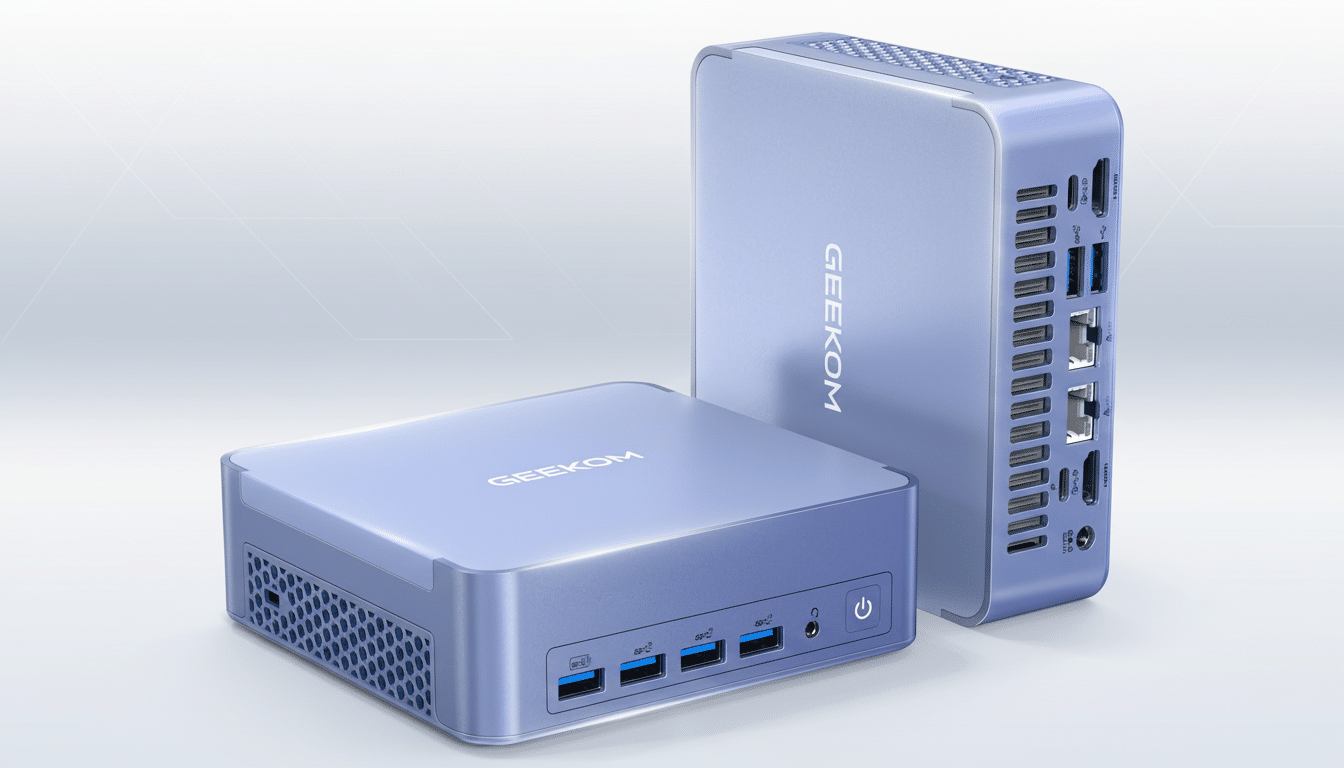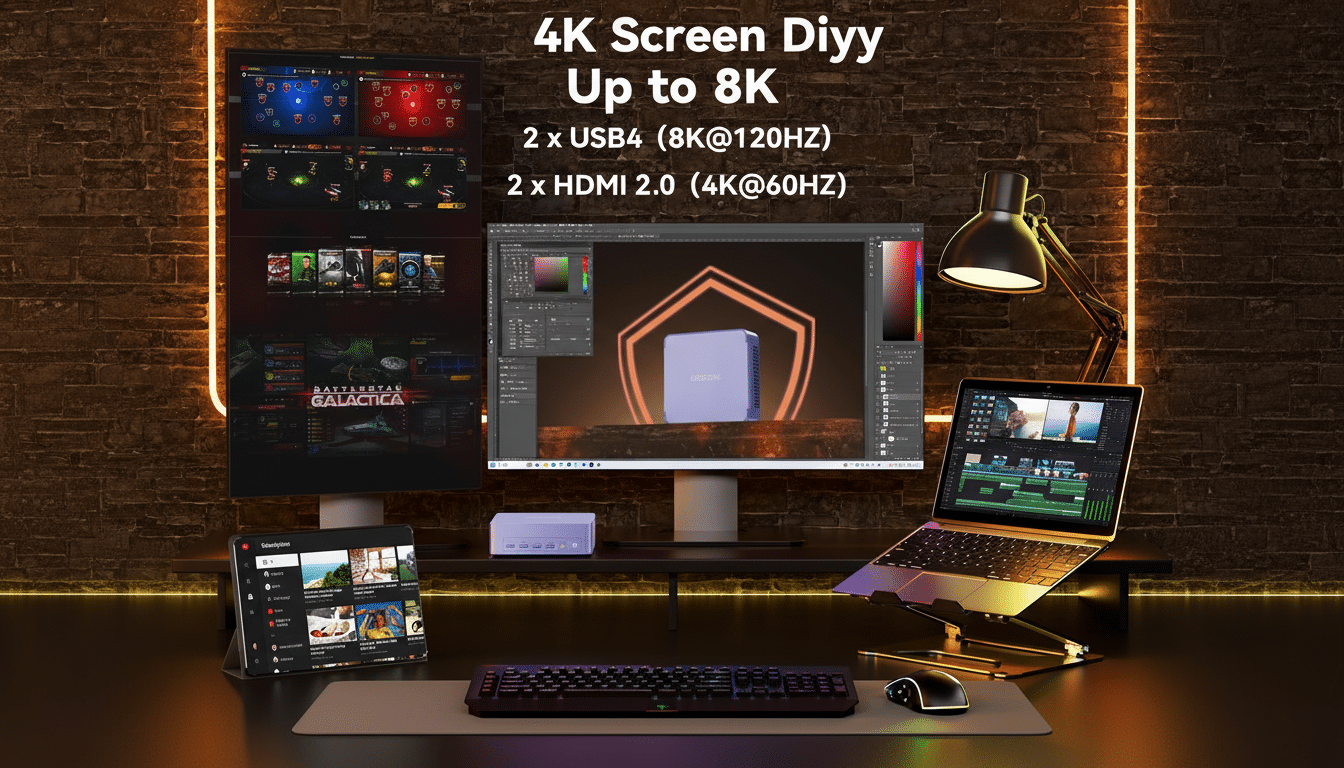The Geekom Mini PC AX8 Max has been discounted to $499 from a list price of $749, representing a 33% saving that works out less expensive than many rivals with the same specs.
For those interested in a compact desktop that still does real work, this is the best price-to-performance play we’ve seen at this configuration.
- Why This Mini PC Deal Offers Exceptional Value Now
- Performance And Specifications, In A Small Package
- Ports and connectivity for real work and daily multitasking
- How It Compares to Other Mini PCs at This Price Point
- Who Should Buy This Mini PC and Why It Fits
- Shopping tips before you check out this Geekom mini PC

Why This Mini PC Deal Offers Exceptional Value Now
Sub-$500 mini PCs tend to skimp on memory, storage, or graphics. Even at this price level, you’re still getting 32GB of DDR5 RAM, a 1TB NVMe SSD, and AMD Radeon 780M integrated graphics alongside a Ryzen 7-class processor — that’s the kind of hardware that more often than not drives the sticker well above $600. For creators, students, and home office users, that mix adds up to faster app launches, smoother multitasking, and less immediate pressure for an upgrade.
Mini PCs have also gained interest as a replacement for full towers because we’re getting much better thermals and core counts out of mobile chips. Compact form factors are a bright spot in the larger desktop market, as observers like IDC point out, with deal-driven cycles turbocharging demand for home and hybrid office arrangements.
Performance And Specifications, In A Small Package
The AX8 Max is built around an AMD Ryzen 7 and Radeon 780M graphics on RDNA 3. Independent testing of similar Ryzen 7 mobile parts by both Notebookcheck and AnandTech indicates multi-core performance comfortably surpasses that of last-generation chips, while the iGPU can play popular esports titles such as Valorant, Rocket League, and Fortnite at 1080p with playable frame rates on tweaked settings. For day-to-day creative work — photo editing in Lightroom, 1080p timeline edits in Premiere Pro, or code compiles — it feels more like a mainstream laptop than a budget desktop.
The included 32GB of dual-channel DDR5 gives some extra muscle to the GPU (integrated graphics benefit from quicker system memory), and the 1TB PCIe NVMe SSD ensures that projects and large apps open quickly. Windows 11 Pro is preinstalled, which matters if you require things like BitLocker, Remote Desktop, or Group Policy features off the bat.
Despite its small(ish) size — similar to a Mac mini in footprint — the unit packs an active cooling solution that should keep clocks as stable as possible under prolonged load. That, in practice, means exporting a batch of RAW photos or building a huge codebase with no slowdowns from thermal throttling, with decent thermals meaningfully suppressing fan noise.
Ports and connectivity for real work and daily multitasking
Half of what makes the AX8 Max great isn’t silicon at all — it’s I/O. That usually encompasses USB4 for high-speed peripherals or a single-cable connection to your monitor dock, dual HDMI for multi-display shenanigans, multiple USB-A ports for your legacy hardware, 2.5Gb Ethernet for ballyhoo-challenging network transfers, and Wi-Fi 6E along with Bluetooth 5.x for modern wireless. Triple-display support is a given here, and it’s easy to drive two 4K monitors plus a projector or get some input from a recording monitor for streaming.

On the inside there are generally two SODIMM slots for memory and an M.2 2280 NVMe bay, so upgrading memory and storage should be doable if your workload increases.
It’s that sort of flexibility that makes mini PCs so much more interesting than most laptops at this price point.
How It Compares to Other Mini PCs at This Price Point
Competitors such as the Minisforum UM790 series and Beelink GTR7 offer comparable AMD platforms but are more often listed in a $599–$799 range when configured with 32GB RAM and 1TB of storage. Intel chips in this class — think Core i7-level — still keep up just fine with single-core tasks, but they can’t usually stick with the painted-on integrated graphics in light gaming or GPU-accelerated scenarios. Assuming you do not need a discrete GPU, the AX8 Max’s combination of CPU threads, 780M graphics, and comprehensive I/O is especially difficult to beat at $499.
Media enthusiasts will find the 780M capable of AV1 and HEVC decoding, making it a great fit for Plex clients or 4K streaming. Puget Systems’ own application benchmarks on similar Ryzen mobile CPUs also demonstrate smooth 1080p editing and fast exports in enthusiast-friendly creator apps when properly tuned, so there’s clear utility for the AX8 Max as a compact creator box.
Who Should Buy This Mini PC and Why It Fits
- Home office workers who want a clean, quiet desk setup with dual or triple monitors.
- Students and developers who require lots of RAM and fast storage for VMs, compilers, or data sets.
- Casual gamers and streaming enthusiasts; expect only 1080p play and HD hardware encoding.
- Creators who want a lightweight, compact workstation for photo editing, podcast production, or light video work.
Shopping tips before you check out this Geekom mini PC
Verify the listing says it has 32GB dual-channel DDR5 and a 1TB NVMe SSD, since those specs contribute a lot of the overall value. If you intend to connect multiple high-resolution displays, make sure you check the fine print for USB4 or HDMI 2.1 support. Compare return windows and warranty terms, and consider adding a second NVMe drive or external USB4 storage if you handle big media projects.
Bottom line: the $499 price makes getting premium mini PC performance affordable for the rest of us, thanks to the Geekom Mini PC AX8 Max. If you have been waiting to shrink your desktop (though not necessarily your capabilities), now is the time to leap.

